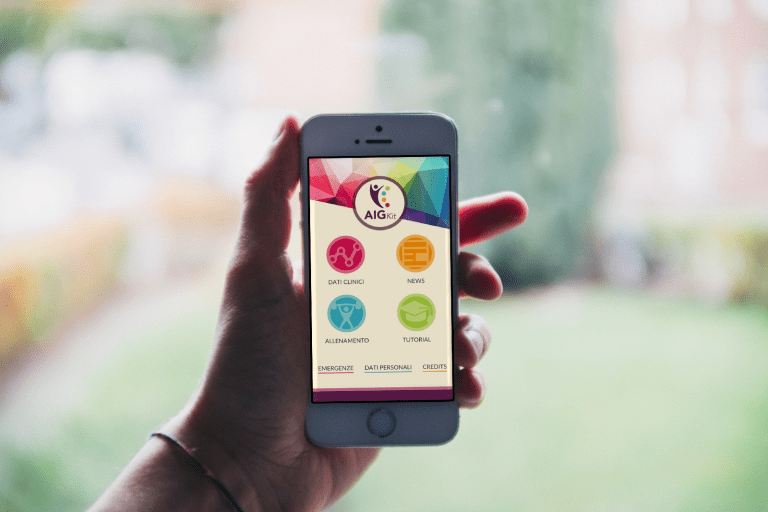AIGkit is a project developed by Vidiemme which falls within the Patient Support Program solution category. It was conceived because of AIG – Italian Glycogeny Association and AIM – Italian Association of Myology, and their desire to help patients suffering from Pompe disease.
This solution was born as a smartphone application for patients, to help them manage their illness and monitor their health.
The application offers the possibility for patients to log their health conditions and activities during the day, to create personalized exercises useful for optimal disease management, and finally it also enables them, in case of emergency, to quickly and easily contact prestored phone numbers, so as to be swiftly reached and assisted.
The project then expanded, giving life to a web portal dedicated to health centers that enables distance-control of the progress of their patients and the collection of a series of data on the disease, useful to the scientific community.
Above all, this periodic flow of information improves the patient/clinic relationship, increases therapy adherence and significantly increases knowledge of the disease.
What is a PSP?
PSPs are programs that offer patient support in all phases of the disease, from diagnosis to the end of treatment, leading to an improvement in quality of life.
Types of PSP
Most PSPs are divided into 3 categories, depending on their function.
There are PSPs that:
- Support patients in taking drugs as prescribed by the clinic of reference (Therapy Adherence)
- Help patients to better understand their condition and offer advice on disease management, providing a series of exercises, feeding plans and informational tutorials on pathologies
- Provide financial assistance or patient reimbursement support services called ‘Patient Assistance Programs’
AIGkit is a PSP that supports patients in therapy adherence, helping them to optimally manage the condition imposed by the disease and increasing scientific knowledge on the disease, with the goal of being a truly effective solution for both patients and the scientific community.
Evolution of the PSP approach
Historically, pharmaceutical companies implemented support programs largely to solve the “Patient Non-Adherence” problem that occurs when the patient does not correctly follow the course of treatment and the prescribed pharmaceutical treatment. These programs were usually Single-Based solutions developed to meet market demands.
On the contrary, the next-generation PSPs will go beyond mere adherence to therapeutic treatment by creating holistic and patient-centric Disease Management.
Advanced PSPs use different methods to increase therapy adherence, including reminders for drug intake or Patient Education (functionality traceable in the AIGkit application under the heading Tutorial) and, above all, do not take into consideration only the approach to the disease or to the pharmacological therapy, but also the characteristics of the patient involved, thus adopting a “Beyond the Pill” approach.
All these concepts expressed up until now are of recent adoption, and the vast scope of the benefits that they bring are still to be entirely understood although some pharmaceutical companies have started to re-evaluate their current services with the aim of strengthening Patient Engagement and increasing Brand Loyalty.
Attention to patients’ needs
Measuring and understanding what services patients actually consult is crucial to channeling resources into improvements and customizations that are useful to offer a truly patient-centric PSP service.
In the development of the AIGkit application, Vidiemme constantly consulted and made use of the support of the AIG and AIM Patient Associations, which played a key role in understanding patients’ needs and identifying the fundamental services to guarantee in order to offer support and help to people with Type II glycogen diseases.
Before starting to develop a program, we need to spend a lot of time and resources in defining the Patient Journey, analyzing patients’ needs during the various phases of therapeutic treatment. It is therefore necessary to have an in-depth knowledge of the patient who experiences the disease, both in its initial phase – and therefore an analysis of previous illnesses – and in its current phase. We begin by listening to the patient’s life history before the diagnosis and then analyzing the manifestation of the symptoms, the motivations behind the choice to contact an HCP (Health Care Provider), the course of therapy and its progression.
Thanks to this holistic approach, all the Patient Journey points can be mapped, providing the patient with the necessary support.
Although it is challenging to know what services are needed for the proper development of a PSP and to understand how to give the right priority to resources and investments, a deep understanding of the Patient Journey is fundamental in reaching the patient support goal that every program of this type sets itself.
But it is comforting to know that we are on the right track: in recent years some of the most innovative pharmaceutical companies have already started to develop and use new-generation PSPs, providing a model to follow and fueling the tendency to adopt similar projects.
Discover AIGkit:
Download the application here in its version for iOS, Android and WindowsPhone.
Sources: dddmag, European Medicine Agency, pharmaphorum


